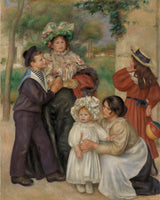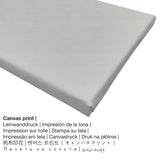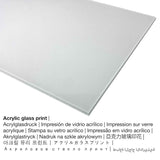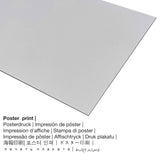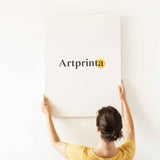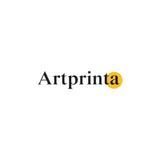Pierre-Auguste Renoir, 1896 - Ezinụlọ nke Artist (ezinụlọ nke onye na-ese ihe) - mbipụta nka mara mma.
Ụtụ gụnyere. Mbupu gbakọrọ na ndenye ọpụpụ.
(© Nwebiisinka - site na Barnes Foundation - Ntọala Barnes)
Painted in 1896, The Artist's Family is Renoir's largest portrait, with life-size figures represented in full length, all of whom have an imposing monumentality. The canvas shows Renoir's wife, Aline, standing at the center, with their 11-year-old son, Pierre, leaning affectionately against her. A two-year-old Jean Renoir toddles in the foreground, attended by the beloved nursemaid Gabrielle Renard; the third son, Claude, was not born until 1901. According to Arsene Alexandre, who claims to have witnessed Renoir at work on the painting, the girl standing opposite Pierre is "simply a little neighbor"; she has also been identified as the daughter of the writer Paul Alexis, who lived next door, and as Marie Isembart.The group is posed in the courtyard in front of 13, rue Girardon, opposite the Chateau de Brouillards in Montmartre, where the Renoir family had moved in 1890. The trees and grassy expanse opening up behind the figures convey the relatively rural character of the Butte de Montmartre during the 1890s; and yet at the same time the bucolic setting seems somewhat exaggerated, as the field stretches on a bit too far, and any sense of the city of Paris, vistas of which are inescapable from that area, is entirely eclipsed. Renoir has clearly idealized his Montmartre neighborhood, presenting it as a rural village rather than as a rapidly developing part of the city.Though Renoir made many paintings of his wife and sons individually, this is his only attempt to present them all together. There is a palpable warmth between the figures, who exchange fond glances and make nonchalant physical contact, as Pierre loops his arms around that of his mother, while the young Jean clutches Gabrielle's sleeve. In its hierarchical presentation of the figures—Madame Renoir presides, while the nursemaid occupies a lower register—Renoir is drawing upon the conventions of 17th-century group portraiture, looking especially to Diego Velazquez, whose Las Meninas he had seen during an 1892 trip to Madrid, and to Anthony Van Dyck. If the arrangement asserts the Renoir family's social status, this is reinforced through the clothing. While Pierre sports a sailor suit that is "customarily worn by sons of the well-to-do," as Colin Bailey has observed, Madame Renoir, who wears a splendid hat and gloves and carries a fur-collared coat, seems to be trying on her newly acquired bourgeois identity. John House notes that following Renoir and Aline's marriage in1890, the Renoir family had become more respectable in the eyes of their bourgeois friends, which this painting certainly reflects; but the inclusion of the neighbor's daughter also suggests the more informal, bohemian circle of which they were a part in Montmartre.While the hierarchical presentation of the figures is symbolic of the various positions within the family, it is also a reflection of Renoir's concern for compositional balance: the heads are arranged in a near-perfect circle—a shape that repeats several times, in the hats and in the ball behind the girl's back. Black and dark blue accents are distributed at even intervals throughout the group's clothing. Even the gazes, especially that between Pierre and the girl, function as part of Renoir's highly designed geometry, as its path locks the two sides of the circle together. By creating such a tightly composed picture, Renoir was surely intending to emphasize the stability of the family unit. It seems very likely that he would have made many studies in preparation for this canvas, especially in light of the important role of drawing in his work from the 1890s.
Onyinye ngwaahịa ebipụta
In 1896 na nwoke onye na-ese ihe Pierre-Auguste Renoir mere nka nka The Artist's Family (The artist's family). Ụdị ihe osise ahụ tụrụ nha - N'ozuzu: 68 1/8 x 54 inch (173 x 137,2 cm) and was made with oil on canvas. What is more, the work of art can be viewed in in the Ụlọ ọrụ Barnes Foundation collection, which home to one of the world's greatest collections of impressionist, post-impressionist and early modernist paintings. With courtesy of - Site n'ikike nke Barnes Foundation, Merion na Philadelphia, Pennsylvania (public domain license).: . Furthermore, alignment is portrait with an image ratio of 1: 1.2, which implies that the length is 20% shorter than the width. Pierre-Auguste Renoir was a illustrator, painter, sculptor of French nationality, whose style can be attributed primarily to Impressionism. The Impressionist artist lived for a total of 78 years - born in 1841 na Limoges, Nouvelle-Aquitaine, France ma nwụọ na 1919 na Cagnes-sur-Mer, Provence-Alpes-Cote d'Azur, France.
Họrọ ihe kacha amasị gị
Anyị na-enye ụdị nha na ihe dị iche iche maka ngwaahịa ọ bụla. Ị nwere ike ịhọrọ nha na ihe kachasị amasị gị n'ime nhọrọ ndị a:
- Glass acrylic ebipụtara nwere mmetụta na-egbuke egbuke: A glossy acrylic glass print, which is often referred to as a UV print on plexiglass, changes your favorite original artwork into beautiful décor. Furthermore, the acrylic glass art print makes a good alternative to canvas or dibond fine art prints. Your favorite artwork is being made with modern UV print technology. It makes intense, deep colors. With an acrylic glass art print contrasts and painting details become more exposed with the help of the very subtle tonal gradation of the print. Our real glass coating protects your custom art replica against sunlight and heat for between 40-60 years.
- Metal (aluminium debond mbipụta): Aluminium Dibond prints are prints on metal with a true depth. A direct Aluminium Dibond Print is the best introduction to fine art prints manufactured on aluminum. For your Print On Aluminum Dibond, we print your favorite work of art on the aluminium white-primed surface. The bright & white parts of the artwork shine with a silk gloss but without the glow. The colors are luminous in the highest definition, the fine details of the print appear clear and crisp, and the print has a a matte appearance you can literally feel.
- Kwaaji: A canvas print is a printed canvas mounted on a wood frame. The advantage of canvas prints is that they are relatively low in weight, which implies that it is easy to hang up the Canvas print without the support of additional wall-mounts. A canvas print is suited for any kind of wall.
- Akwụkwọ mmado ebipụtara (akwa akwa akwa): Our poster print is a printed flat canvas with a fine finish on the surface, which resembles the actual masterpiece. Please keep in mind, that depending on the size of the poster print we add a white margin 2-6cm around the print, which facilitates the framing with your custom frame.
Banyere onye na-ese ihe
| Aha onye nka: | Pierre-Auguste Renoir |
| Aliases: | p.a. renoir, רנואר אוגוסט, רנואר פייר אוגוסט, Renoir Pierre-Auguste, Renoir, Renuar Ogi︠u︡st, firmin auguste renoir, renoir p.a., Renoir Auguste, Renoir August, Renoar Pjer-Ogist, renoir a., Auguste Renoir, pierre august renoir, Renoir Pierre August, Renoir Pierre Auguste, a. renoir, Pierre-Auguste Renoir, August Renoir, Pierre Auguste Renoir |
| okike nke onye nka: | nwoke |
| Nationality: | French |
| Ọrụ nke onye na-ese ihe: | onye na-ese ihe, onye na-ese ihe, onye na-ese ihe |
| Mba onye si: | France |
| Nkewa onye nka: | omenkà nke oge a |
| styles: | Mmetụta |
| Oge ndu: | 78 afọ |
| Afọ amụrụ: | 1841 |
| Obodo: | Limoges, Nouvelle-Aquitaine, France |
| Afọ ọnwụ: | 1919 |
| Nwụrụ na (ebe): | Cagnes-sur-Mer, Provence-Alpes-Cote d'Azur, France |
Data nka ahaziri
| Aha nke ihe nka: | "The Artist's Family (The artist's family)" |
| nhazi ọkwa: | sere |
| Otu sara mbara: | nkà nke oge a |
| Time: | 19th narị afọ |
| Afọ nka: | 1896 |
| Afọ nka: | 120 afọ |
| Ihe osise izizi: | mmanụ na kwaaji |
| Nha nke ihe osise izizi: | N'ozuzu: 68 1/8 x 54 inch (173 x 137,2 cm) |
| Ụlọ ihe ngosi nka / ebe: | Ntọala Barnes |
| Ebe ebe ngosi nka: | Philadelphia, Pennsylvania, Njikota Obodo Amerika |
| Ibe weebụ: | www.barnesfoundation.org |
| Ụdị nka nka: | ngalaba ọha |
| Site n'aka: | Site n'ikike nke Barnes Foundation, Merion na Philadelphia, Pennsylvania |
Banyere ihe a
| Ụdị edemede: | ezi nka mmeputakwa |
| Mmeputakwa: | dijitalụ mmeputakwa |
| Usoro mmepụta: | mbipụta dijitalụ |
| Production: | German mere |
| Stockdị ngwaahịa: | mmepụta ihe na-achọ |
| Ojiji ngwaahịa: | foto mgbidi, ihe ndozi mgbidi |
| Ndozi onyonyo: | usoro eserese |
| Oke akụkụ onyonyo: | ogologo ruo obosara 1: 1.2 |
| Ntụgharị nkọwa akụkụ akụkụ: | ogologo bụ 20% mkpụmkpụ karịa obosara |
| Nhọrọ akụrụngwa: | ígwè ebipụta (aluminium dibond), acrylic glass print (nwere ezigbo mkpuchi iko), mbipụta akwụkwọ mmado (akwụkwọ kwaaji), akwụkwọ akwa akwa. |
| Mbipụta kanvas (akwa akwa na etiti ihe ndọtị) dị iche iche: | 50x60cm - 20x24", 100x120cm - 39x47", 150x180cm - 59x71" |
| Mbipụta iko acrylic (nke nwere ezigbo mkpuchi iko): | 50x60cm - 20x24", 100x120cm - 39x47", 150x180cm - 59x71" |
| Mpempe akwụkwọ mmado (akwụkwọ kwaaji) nha: | 50x60cm - 20x24", 100x120cm - 39x47" |
| Nhọrọ aluminom dibond (ihe aluminom) nhọrọ: | 50x60cm - 20x24", 100x120cm - 39x47" |
| Igwe onyonyo: | biko mara na ngwaahịa a enweghị okpokolo agba |
Important legal note: We try whatever we can in order to describe our products as clearly as possible and to exhibit them visually on the various product detail pages. Although, the tone of the printing material and the print result might vary marginally from the presentation on the screen. Depending on the screen settings and the condition of the surface, not all color pigments are printed 100% realistically. In view of the fact that the art reproductions are printed and processed by hand, there might as well be slight discrepancies in the motif's exact position and the size.
Nwebiisinka © | Artprinta.com

